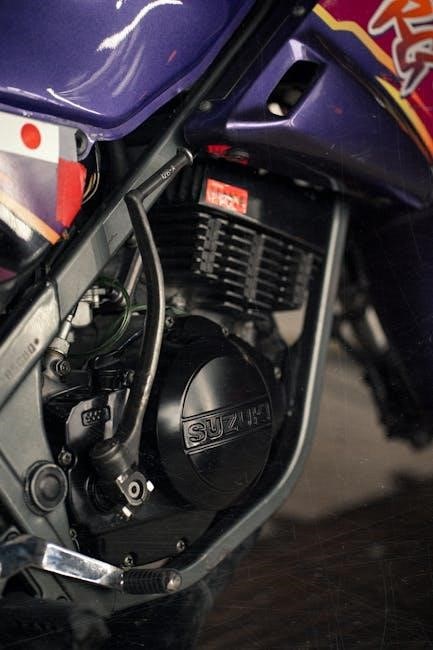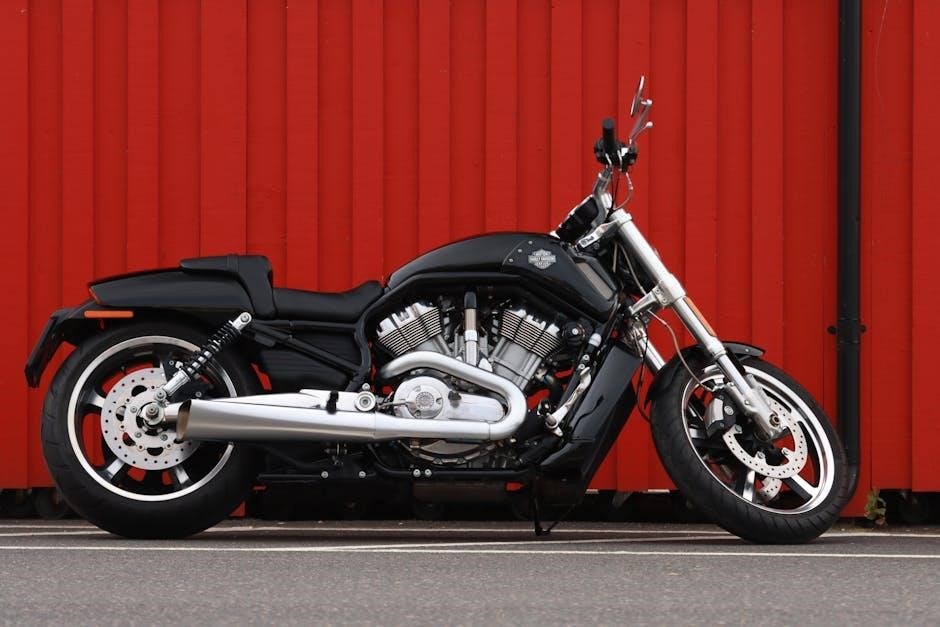NEMA motor frame sizes provide standardized dimensions for electric motors, ensuring compatibility and simplifying selection․ These frames, like 286T, define key physical dimensions, aiding engineers in specifying motors accurately for various applications․

1․1 Overview of NEMA Standards
NEMA (National Electrical Manufacturers Association) standards provide a common framework for motor manufacturers, ensuring consistency in design and performance․ These standards include specifications for motor frame sizes, shaft heights, and mounting dimensions, enabling compatibility across different applications․ NEMA frame sizes, such as 286T, are designated to indicate specific physical dimensions, making it easier for engineers to select and replace motors․ The standards also promote interchangeability and simplify the selection process for users․
1․2 Importance of Motor Frame Sizes
Motor frame sizes are critical for ensuring proper fitment and performance in industrial and commercial applications․ They determine the physical dimensions, shaft height, and mounting configuration, ensuring compatibility with existing equipment․ Accurate frame size selection prevents mechanical misalignment and operational inefficiencies, while also simplifying maintenance and replacement processes․ Adherence to NEMA standards guarantees consistency, making frame size a vital factor in motor specification and installation across various industries․
1․3 Purpose of the NEMA Frame Size Chart
The NEMA frame size chart serves as a comprehensive guide for engineers and technicians, providing standardized motor dimensions․ It ensures consistency across manufacturers, simplifying motor selection and replacement․ The chart details key measurements such as shaft height, mounting dimensions, and bolt patterns, enabling precise compatibility checks․ This tool is essential for maintaining operational efficiency and reducing downtime in industrial applications by offering a unified reference for motor frame specifications․
Understanding NEMA Frame Size Designations
NEMA frame size designations, such as 286T, standardize motor dimensions, ensuring compatibility across manufacturers․ These designations help engineers specify and replace motors accurately and efficiently․
2․1 Key Dimensions in NEMA Frame Sizes
Key dimensions in NEMA frame sizes include shaft height, mounting dimensions, and overall frame size․ These measurements ensure compatibility across manufacturers and applications․ Shaft height is critical for alignment, while mounting dimensions dictate how the motor attaches to equipment․ Standardized tolerances ensure precise fits, reducing installation issues․ Understanding these dimensions is essential for motor selection, maintenance, and replacement, as they directly impact performance and reliability in industrial and commercial settings․
2․2 Shaft Height and Mounting Dimensions
Shaft height and mounting dimensions are critical for motor compatibility․ Shaft height varies across frames, ensuring proper alignment with driven equipment․ Mounting dimensions, including bolt patterns and face dimensions, must match existing setups․ These measurements are standardized in NEMA charts, allowing engineers to specify motors accurately․ Proper alignment prevents vibration and extends equipment life, making these dimensions vital for efficient and reliable operation in industrial applications․
2․3 Frame Size Nomenclature (e․g․, 286T)
NEMA frame size designations, such as 286T, provide essential information․ The numeric part (286) indicates specific dimensions, while the suffix (T) denotes special features or modifications․ This nomenclature ensures clarity and consistency, helping users identify motor characteristics quickly․ The standardized format aids in selecting the correct motor for specific applications, ensuring compatibility and performance․ Understanding the nomenclature is key to interpreting NEMA charts accurately․

NEMA Frame Size Chart Details
The chart outlines standard motor dimensions, including shaft heights, mounting details, and bolt patterns, ensuring compatibility across applications․ It provides precise measurements for frames like 286T․
3․1 Typical Dimensions for Common Frame Sizes
Common NEMA frame sizes, such as 42, 48, and 56, have standardized dimensions․ For instance, frame 42 has a shaft height of 2․625 inches, while frame 56 measures 3․5 inches․ These dimensions ensure compatibility across applications, simplifying motor selection․ Mounting details and bolt patterns are also specified, providing a clear reference for engineers․ The chart includes both imperial and metric measurements, enhancing its utility for global applications․
3․2 Shaft Height and Diameter Variations
Shaft height and diameter vary significantly across NEMA frame sizes․ For example, frame 56 has a 3․5-inch shaft height, while larger frames like 140T feature diameters up to 5․3 inches․ These variations accommodate different power requirements and application needs․ The chart provides precise measurements, ensuring accurate motor selection and compatibility․ This consistency is crucial for maintaining efficiency and performance in industrial and commercial settings․
3․3 Mounting Dimensions and Bolt Patterns
NEMA motor frame size charts detail precise mounting dimensions and bolt patterns, ensuring proper alignment and secure installation․ For example, frame 56 motors have specific bolt circle diameters and mounting hole arrangements․ These standardized dimensions ensure compatibility with various applications and prevent installation errors․ The charts also specify the number and location of mounting bolts, critical for maintaining motor balance and efficiency․ This data is essential for engineers to ensure accurate and reliable motor installations across industries․

Significance of NEMA Frame Numbers
NEMA frame numbers are crucial for identifying motor size and mounting compatibility․ They standardize dimensions, ensuring motors fit specific applications and meet performance requirements efficiently․
4․1 Frame Number Breakdown (e․g․, 286T)
The NEMA frame number, such as 286T, provides critical information about the motor’s physical dimensions and features․ The first two digits (28) indicate the frame size, which determines shaft height and mounting dimensions․ The next digit (6) specifies the motor’s configuration, while the suffix (T) denotes special features or modifications․ This standardized breakdown ensures compatibility and simplifies motor selection for engineers and technicians, aligning with application requirements and maintenance needs․
4․2 Frame Size and Motor Power Relationship
NEMA frame size and motor power are closely linked, as larger frames typically accommodate more powerful motors․ The frame size determines the physical dimensions, including shaft height and mounting features, which directly relate to the motor’s power output․ Engineers use NEMA frame size charts to match motor power requirements with specific applications, ensuring optimal performance and efficiency․ This relationship helps in selecting the right motor for industrial, commercial, or residential uses, balancing power needs with physical constraints․
4․3 Frame Size and Application Suitability
NEMA frame sizes are tailored for specific applications, ensuring motors meet performance and dimensional requirements․ Smaller frames suit compact applications, while larger frames are ideal for heavy-duty machinery․ The standardized dimensions enable compatibility across various industries, from industrial machinery to residential equipment․ Proper frame size selection ensures efficient operation, reducing mechanical stress and optimizing performance for the intended use․ This alignment is critical for reliability and longevity in diverse operational environments․

C-Face and Rigid Mount Dimensions
C-Face and Rigid Mount dimensions are standardized in NEMA charts, ensuring compatibility and ease of installation․ These specifications define bolt patterns, shaft heights, and mounting surfaces for motors․
5․1 C-Face Mounting Dimensions
C-Face mounting dimensions are standardized in NEMA charts, providing specific measurements for bolt patterns, shaft heights, and motor mounting surfaces․ These dimensions ensure compatibility across different motor frames, simplifying installation and replacement․ For example, a 324 frame might have a bolt circle diameter of 10․5 inches and a shaft height of 4․625 inches․ These standardized measurements allow for seamless integration of motors into various industrial applications, ensuring proper alignment and secure mounting․

5․2 Rigid Mount Motor Frame Dimensions
Rigid mount motor frames have defined dimensions for bolt circle diameters, shaft heights, and other critical measurements․ For instance, a 324 frame may have a bolt circle of 10․5 inches and a shaft height of 4․625 inches, while a 326 frame could feature a 12-inch bolt circle and a 5․375-inch shaft height․ These dimensions ensure proper alignment and secure installation, critical for industrial applications․ Rigid mount frames are designed for stability, minimizing vibration and ensuring reliable operation in demanding environments․
5․3 Comparison of C-Face vs․ Rigid Mount
C-Face and Rigid Mount motor frames differ in installation methods․ C-Face motors have a mounting flange with a specific bolt pattern, simplifying alignment and reducing installation time․ Rigid Mount frames use a bolt circle directly on the motor’s base, offering greater stability and reduced vibration․ Both designs meet NEMA standards, ensuring compatibility, but Rigid Mounts are preferred in heavy-duty applications due to their robust construction and enhanced performance under stress, while C-Face mounts are ideal for applications requiring ease of installation and flexibility․
AC Foot-Mounted Motor Dimensions
AC foot-mounted motors feature standardized NEMA frame dimensions, including shaft height and extension lengths, ensuring compatibility and ease of installation in various industrial applications․
6․1 Single Straight-Shaft Extension Motors
Single straight-shaft extension motors are commonly used in industrial applications, featuring a single shaft extension for mounting․ NEMA frame sizes like 42, 48, and 56 specify shaft heights and diameters, ensuring compatibility․ These dimensions are critical for motor replacement and new installations․ Engineers rely on these standards to ensure proper fitment and performance in machinery․
The shaft height and diameter vary by frame size, with larger frames accommodating heavier loads․ This consistency simplifies design and maintenance processes, making NEMA standards indispensable in motor selection and application;
6․2 Double-Shaft Extension Motors
Double-shaft extension motors feature two shafts, allowing for dual-sided drive capabilities․ NEMA frame sizes specify both shaft heights and diameters, ensuring precise alignment and mounting․ These motors are ideal for applications requiring simultaneous power transmission from both ends, enhancing operational flexibility․ The standardized dimensions ensure compatibility across various industrial setups, simplifying installation and maintenance processes․ This design is particularly useful in heavy-duty machinery where dual-drive systems are essential for optimal performance․

6․3 Specialized Motor Dimensions
Specialized motor dimensions cater to unique applications, offering tailored solutions beyond standard frames․ These motors often include custom shaft configurations, extended mounting options, or enhanced features for specific industries․ NEMA charts detail these specialized dimensions, ensuring precise fitment for niche requirements․ Engineers rely on these specifications to optimize performance in demanding environments, whether for high-torque applications or specialized machinery․ The attention to detail in these designs underscores NEMA’s commitment to versatility and adaptability in motor design․

Suffix Letters in NEMA Frame Sizes
Suffix letters in NEMA frame sizes indicate special modifications or features, such as unique mounting or cooling options․ These letters ensure the motor meets specific application requirements․
7․1 Meaning of Suffix Letters (e․g․, T, U, T)
Suffix letters in NEMA frame sizes, such as T or U, denote specific motor modifications․ The letter T often signifies a special thrust bearing, while U may indicate a unique mounting configuration․ These suffixes provide critical details about the motor’s design, ensuring it meets specific application needs․ Understanding these letters is essential for proper motor selection and installation․ They are not part of the standard frame size but modify it for particular uses․
7․2 Special Frame Modifications
Special frame modifications in NEMA standards are indicated by suffix letters, such as T or U, which denote specific design changes․ These modifications may include custom mounting configurations, unique shaft features, or specialized bearings․ They ensure motors meet particular application requirements, such as increased load capacity or specific environmental conditions․ These modifications are crucial for tailored performance and compatibility, making each motor suitable for its intended use without compromising standard frame size specifications․
7․3 Examples of Suffix Applications
Suffix letters in NEMA frame sizes, such as T or U, indicate specific modifications․ For example, the T suffix often denotes a special shaft configuration, while the U suffix may signify a unique mounting arrangement․ These suffixes guide engineers in selecting motors tailored to specific applications, ensuring compatibility and performance․ Common examples include modified shaft heights or specialized bearings, which are critical for meeting the demands of unique industrial or commercial environments while maintaining standard frame size dimensions․
NEMA vs․ IEC Frame Size Comparison
NEMA and IEC frame sizes differ in standards, with NEMA focusing on inches and IEC on millimeters․ This comparison aids engineers in global motor selections, ensuring compatibility and performance across different regions․
8․1 Differences in Frame Size Designations
NEMA frame sizes are designated with a combination of numbers and letters, such as 286T, where the number represents shaft height and the letter indicates specific motor features․ In contrast, IEC frames use a numeric system based on millimeters, focusing on shaft height and motor power․ These differing designations reflect regional standards, with NEMA primarily used in North America and IEC in Europe and globally․ Understanding these differences is crucial for motor compatibility and application suitability in various markets․

8․2 Conversion Between NEMA and IEC Frames
Converting NEMA to IEC frames involves aligning shaft heights and power ratings․ For instance, a NEMA 284T frame corresponds to an IEC 90 frame, both sharing similar shaft heights and power outputs․ This conversion ensures motor compatibility in global applications, allowing engineers to select appropriate frames for different regions․ Proper alignment of these dimensions is crucial for maintaining performance and efficiency across diverse electrical standards and industrial requirements․
8․3 Key Considerations for Global Applications
When selecting motors for global applications, consider local electrical standards and environmental factors․ NEMA frames are common in North America, while IEC frames dominate elsewhere․ Ensure compliance with regional voltage and efficiency standards, and verify shaft dimensions and mounting styles for compatibility; Proper frame selection enhances performance and longevity, reducing operational risks in diverse industrial settings․

Applications of NEMA Frame Size Charts
NEMA frame size charts are essential for motor replacement, maintenance, and design․ They ensure compatibility and accuracy, aiding engineers in selecting the right motor for specific applications efficiently․
9․1 Motor Replacement and Maintenance
NEMA frame size charts are indispensable for motor replacement and maintenance, ensuring compatibility and proper fit․ By referencing the chart, technicians can identify the exact frame number (e․g․, 286T) from the motor’s nameplate, which specifies critical dimensions like shaft height, diameter, and bolt patterns․ This ensures the replacement motor aligns perfectly with existing machinery, minimizing downtime and potential damage․ The charts also guide maintenance tasks, such as verifying mounting dimensions and shaft alignment, which are vital for smooth operation and longevity of the motor and connected equipment․
9․2 Design and Engineering Applications
NEMA frame size charts are vital tools in design and engineering, offering precise motor dimensions for system integration․ Engineers utilize these charts to select motors that fit specific applications, ensuring optimal performance․ By referencing key dimensions like shaft height, frame size, and mounting patterns, designers can create compatible machinery layouts․ This ensures seamless integration with existing systems, reducing design errors and enhancing overall system efficiency․ The charts also facilitate compliance with industry standards, streamlining the design process and improving project outcomes․
9․3 Troubleshooting Motor Compatibility
Engineers use NEMA frame size charts to troubleshoot motor compatibility issues, ensuring proper fit and performance․ By verifying frame numbers and dimensions, they can identify mismatches in shaft height, diameter, or mounting patterns․ The chart also helps confirm if the frame size aligns with the required horsepower, preventing undersizing or oversizing․ Additionally, it aids in detecting variations in bolt patterns or special modifications, guiding necessary adjustments for seamless integration and optimal functionality, minimizing downtime and enhancing system reliability․
How to Read the NEMA Frame Size Chart
Identify key dimensions like frame size, shaft height, and mounting details․ Understand dimension tolerances and use the chart to select motors that match application requirements precisely․
10․1 Identifying Key Dimensions
When analyzing the NEMA frame size chart, focus on essential measurements such as frame size, shaft height, and mounting dimensions․ These details are critical for ensuring motor compatibility with specific applications․ The frame size, often denoted as a number-letter combination (e․g․, 286T), indicates the motor’s physical dimensions․ Shaft height and diameter are vital for shaft alignment and coupling compatibility․ Mounting dimensions, including bolt patterns and foot sizes, ensure proper installation and secure fitment․ By identifying these key dimensions, users can accurately select motors that meet their mechanical and operational requirements effectively․ Proper identification prevents mismatches and ensures optimal performance․
10․2 Understanding Dimension Tolerances
Dimension tolerances in the NEMA frame size chart specify acceptable ranges for motor dimensions, ensuring compatibility and proper fitment․ These tolerances account for minor variations in manufacturing, material, and design․ By understanding these limits, engineers can ensure motors meet required specifications while accommodating potential deviations․ Tolerances are standardized to maintain consistency across manufacturers, preventing installation issues and ensuring reliable performance․ Properly interpreting these ranges is critical for selecting motors that align with application needs and maintaining operational efficiency․
10․3 Using the Chart for Motor Selection
The NEMA frame size chart is an essential tool for selecting the right motor by matching dimensions and specifications․ By cross-referencing frame numbers, shaft heights, and mounting details, engineers can identify compatible motors for specific applications․ Understanding the frame nomenclature and suffixes ensures accurate selection․ The chart simplifies the process of comparing motor sizes, enabling efficient and reliable performance․ Proper use of the chart minimizes errors and ensures motors meet application requirements effectively․
NEMA motor frame size charts are essential for ensuring compatibility and efficiency in motor applications․ They standardize dimensions, simplify selection, and promote accurate frame size identification for optimal performance․
11․1 Summary of Key Points
NEMA motor frame size charts standardize dimensions for electric motors, ensuring compatibility and simplifying selection․ They provide detailed measurements, including shaft height, mounting dimensions, and frame nomenclature․ These charts help engineers identify suitable motors for specific applications, ensuring optimal performance․ Understanding frame designations, like suffix letters, is crucial for accurate selection․ Proper frame size selection prevents mechanical and operational issues, while incorrect choices can lead to inefficiency or system failure․ NEMA standards ensure reliability and consistency across motor applications․
11․2 Importance of Accurate Frame Size Selection
Accurate NEMA frame size selection is critical to ensure proper motor performance and system compatibility․ Incorrect frame sizes can lead to mechanical misalignment, operational inefficiencies, or even system failure․ Proper selection guarantees optimal power output, efficiency, and longevity of the motor․ Engineers must consult NEMA charts to match motor dimensions with application requirements, avoiding costly errors․ This ensures seamless integration and reliable operation, making accurate frame size selection a cornerstone of effective motor system design and maintenance․
11․3 Final Thoughts on NEMA Frame Size Charts
NEMA frame size charts are a cornerstone for motor applications, providing standardized dimensions that ensure compatibility and efficiency․ By adhering to these charts, engineers can streamline motor selection, reduce errors, and optimize system performance․ Their utility extends to troubleshooting and design, making them indispensable for both maintenance and innovation․ Embracing NEMA standards fosters reliability, cost-effectiveness, and scalability in motor systems, solidifying their importance in modern engineering practices․
